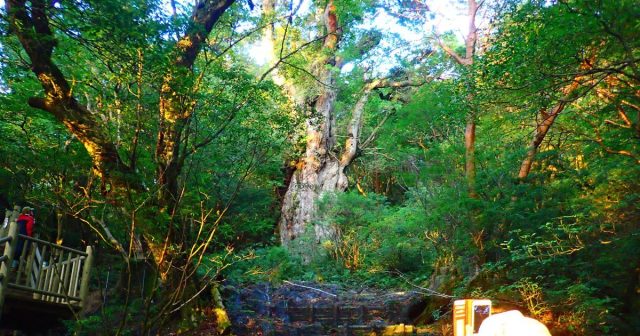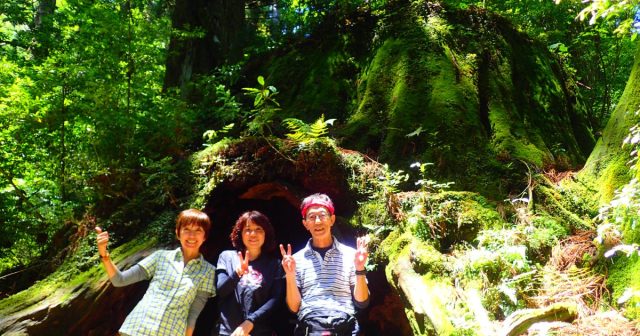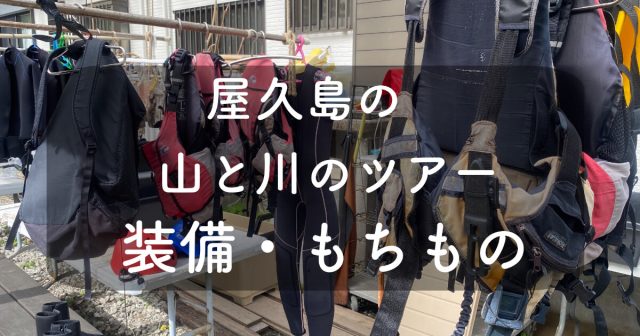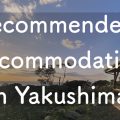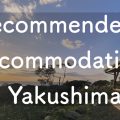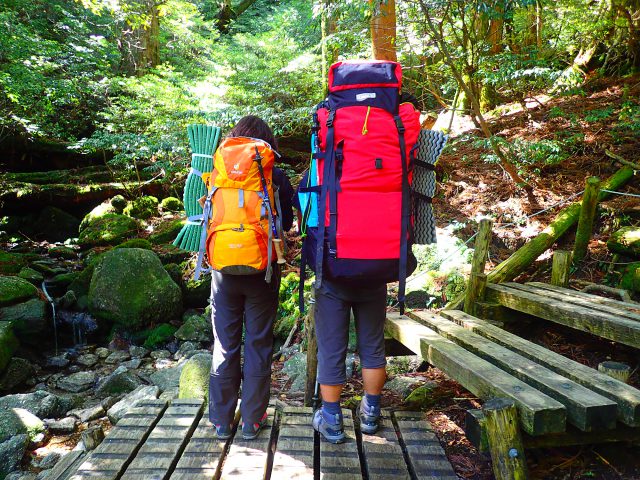
Hello! This is Yakushima Island Guide Shima Asobi (*^^*)
Since I'm on Yakushima, I want to go trekking to the Jomon and Yakusugi cedars!
But a day hike seems like a tough one... Maybe a two-day trip with one night's stay would be better, since the walking distance would roughly be half as long?
But what are the mountain huts and toilets like? There are so many things I don't know. (^_^;)
To help those who are new to mountain accommodation feel at ease, I've compiled a list of questions and concerns I've received from my guests, such as, "What do other people do?"
If you're interested, please read on! I hope it helps with your mountain climbing plans. (^^)/
And for more on the history of Jomon Sugi and why we recommend a two-day, one-night Jomon Sugi camping trip, check out this blog! ♪
(Climbing the mountain after learning about this is even more moving (*'ω'*))
And, the blog below introduces "recommended guesthouses and hotels" and "car rentals" on Yakushima!
Please take a look at that too~(^o^).
目次
- 1 Are you prepared with your mountain climbing gear and belongings?
- 2 How to get to the Arakawa trailhead (About the mountain bus and preparing tickets in advance)
- 2.1 How to get from Yakusugi Nature Museum to the Arakawa Trailhead (Buy your bus ticket the day before!)
- 2.2 Arakawa Mountain Climbing Bus Ticket (Shuttle Bus) Prices and Contributions
- 2.3 Information on where to buy mountain climbing bus tickets
- 2.4 Arakawa Tozan Bus Timetable (March-November 2025)
- 2.5 What is the Arakawa Trailhead like? What's there?
- 2.6 About mountaineering registration
- 3 Toilet situation in the mountains of Yakushima
- 4 Can I use my cell phone (smartphone/iPhone) in the mountains? (Arakawa trailhead round trip route)
- 5 Uninhabited huts on the Jomon Sugi course (Takatsuka Hut, Shin-Takatsuka Hut) / Tent camping
- 6 Things to keep in mind when staying overnight in the mountains
- 6.1 Don't worry, there are no bears or wild boars on Yakushima!
- 6.2 Protect your food from Himenezumi(Small Mouse)!
- 6.3 Double check the locations of water sources and toilets before it gets dark! ~It's easy to get there, but it's hard to get lost on the way back~
- 6.4 When you leave, be sure to take your trash and anything you brought with you!
- 7 Can I retire during the trekking tour?
- 8 Tobacco in the Mountains
- 9 Summary
Are you prepared with your mountain climbing gear and belongings?
Please double-check your hiking boots, backpack, and rainwear!
When climbing Jomon Sugi, as you might expect, the equipment and belongings you bring will differ and even increase depending on whether you're doing a day trip or an overnight stay, so you'll need to be well-prepared.
The following explains what equipment and luggage you should bring, so please take a look for reference (^∀^).
How far (km) is it to Jomon Sugi (Yakusugi)?
The one-way trip is 11km, consisting of 8.5km of trolley track (about 3 hours) and 2.5km of mountain path (about 2 hours).
That's 22km round trip (*_*).
I'll cover this distance (22km) and return in two days.
That's right, my wife often says, "Whether it's a day trip or an overnight stay, wearing thick, mountaineering socks makes a big difference in how tired you feel the next day!" When I take my kids Mountain climbing, shoes are important, but we also make sure they wear Mountain climbing or thick socks.
Mountain climbing socksMany people don't feel that tired when climbing, but when descending, or when the descent continues, the weight of your body and the luggage you're carrying really hits your hips and legs. The strain is actually enormous.
It's also useful to have a trekking pole.
Prepare yourself for various equipment and belongings, and prepare yourself mentally to not give up! Let's head for Jomon Sugi ٩( 'ω' )و!
Mountaineering equipment rental shop
Yakushima has many rental shops for mountaineering equipment.
If you prepare your gear there, you'll have less luggage to carry, so renting is a good option.
Click here for Yakushima mountaineering equipment rental shops!
How to get to the Arakawa trailhead (About the mountain bus and preparing tickets in advance)
How to get from Yakusugi Nature Museum to the Arakawa Trailhead (Buy your bus ticket the day before!)
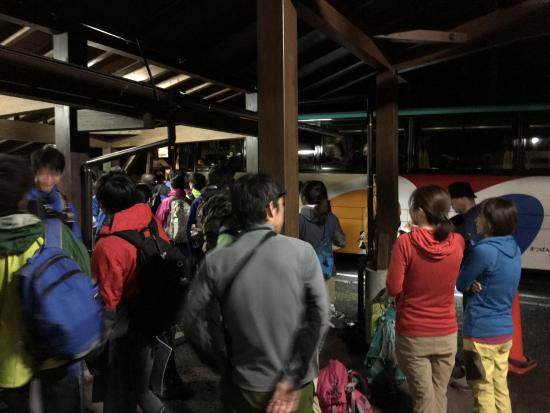
The Arakawa trailhead, the starting point of the Jomon Sugi trek, is closed to private vehicles from March to November each year, so you cannot reach the trailhead by private car or rental car.
You can get there by shuttle bus or taxi from the Yakusugi Nature Museum.
If you're taking the shuttle bus, it's recommended that you purchase your bus ticket the day before. .
(You can also purchase tickets at the bus shelter on the day, but there will be long lines if it's busy, and they only accept cash.^^;)
Arakawa Mountain Climbing Bus Ticket (Shuttle Bus) Prices and Contributions
Yakusugi Nature Museum to Arakawa Trailhead (approx. 35 minutes)
Shuttle bus ticket: 1,000 yen one way, 2,000 yen round trip (as of November 2025)
Mountaineering Contribution Fee [Day Trip: 1,000 yen] [Overnight Trip: 2,000 yen]
Information on where to buy mountain climbing bus tickets
| Office Name | Opening Hours | Phone Number |
|---|---|---|
| Yakushima Anbo Tourist information Center (Inside Yakushima Town General Center) (Anbo) View on Google Maps | 9:00~18:00 | 0997-46-2333 |
| Tourist information center in front of Yakushima Airport (In front of Yakushima Airport) View on Google Maps | 8:30~18:00 | 0997-49-4010 |
| Yakushima Environmental Culture Village Center Counter (Miyanoura) View on Google Maps | 9:00~17:00 | 0997-42-2900 |
| Arakawa Mountain Climbing Bus Stop (Yakusugi Nature Museum Bus Stop) (Anbo) View on Google Maps | 4:30~19:00 (Closed 6:30~10:30) | 0997-46-3317 |
Arakawa Tozan Bus Timetable (March-November 2025)
Service may be suspended in bad weather, when a typhoon is approaching, or when warnings (heavy rain, strong winds) are issued. If this applies to you, be sure to check before embarking on your trekking adventure safely. (^o^)/.
| 【Going】Yakusugi Nature Museum → Arakawa Trailhead | 【Returning】Arakawa Trailhead → Yakusugi Nature Museum |
|---|---|
| Depart 5:00 → Arrive 5:35 | Depart 6:20 → Arrive 6:55 |
| ※Departure at 5:20 → Arrival at 5:55 | Departure at 15:00 → Arrival at 15:35 |
| Departure at 5:40 → Arrival at 6:15 | Departure at 16:00 → Arrival at 16:35 |
| Departure at 14:00 → Arrival at 14:35 | ※Departure at 16:30 → Arrival at 17:05 |
| Departs 5:00 PM → Arrives 5:35 PM | |
| Departs 5:45 PM → Arrives 6:20 PM |
Check the Arakawa Tozan Bus operation status!
The decision to cancel the tour is usually made around the evening of the previous day, so if you're planning to climb Jomon Sugi the next day, be sure to check. (^_^) If you've booked a tour or guide, you'll likely receive a cancellation or change notice.
For daily Arakawa Tozan Bus operating status, please refer here! (From Official X: Old Twitter)
What is the Arakawa Trailhead like? What's there?
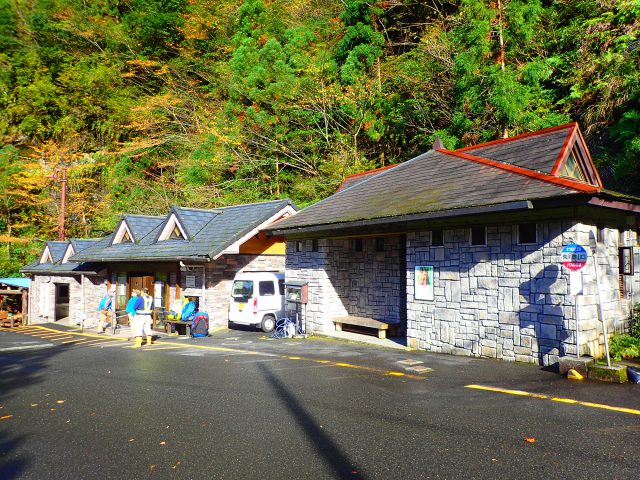
The Arakawa Trailhead is the gateway to starting your Jomon Cedar trek.
The Arakawa trailhead is located at an altitude of approximately 600m, approximately 35 minutes by shuttle bus from the bus stop in the Yakusugi Nature Museum bus parking lot.
By the way, the only way to get to the Arakawa trailhead is by shuttle bus or taxi. (From March 1st to November 30th.)
There is a waiting area (with two small changing rooms)
When you arrive at the Arakawa trailhead, there will be a waiting room right in front of you. If it rains, you can eat your breakfast or put on your rain gear.
*There are two small changing rooms inside the waiting room (on the left side as you face the trailhead).
However, since it often gets crowded, it may be a good idea to put on your rain gear in advance if the weather looks bad.
Restrooms available / No trash cans or vending machines
By the way, guests often ask, but please note that there are no garbage dumps or vending machines!
Also, there are restrooms in the building next to the waiting area (women's restrooms are on the left as you face the front, and men's restrooms are on the right), so be sure to use them before you leave!
During peak season, the restrooms here can get very crowded quickly, so be sure to time your visit accordingly and go early.
*By the way, there is a "used portable toilet collection box" located between the waiting room and the women's restroom. Please dispose of your used portable toilet here on your way out.
About mountaineering registration
If you are joining a guided tour, you do not need to submit a mountain climbing report. However, if you are climbing without a guide, you must submit one.
Submitting a mountain climbing report is extremely important, as it will facilitate a smooth search in the event of an accident or getting lost.
For guided tours, mountain climbing reports are not required, as guides communicate with each other and use walkie-talkies.
By the way, you can also submit your mountaineering registration online.
↓ ↓ ↓
Click here to submit your climbing registration online!
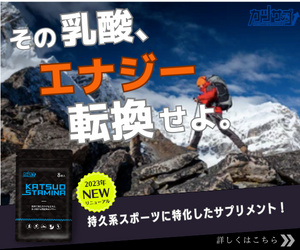
Toilet situation in the mountains of Yakushima
When planning a hike, one thing you can't ignore is the toilet situation in the mountains.
So, be sure to know the locations of existing toilets, portable toilet booths, and used portable toilet collection boxes (there were some at the Arakawa trailhead!).
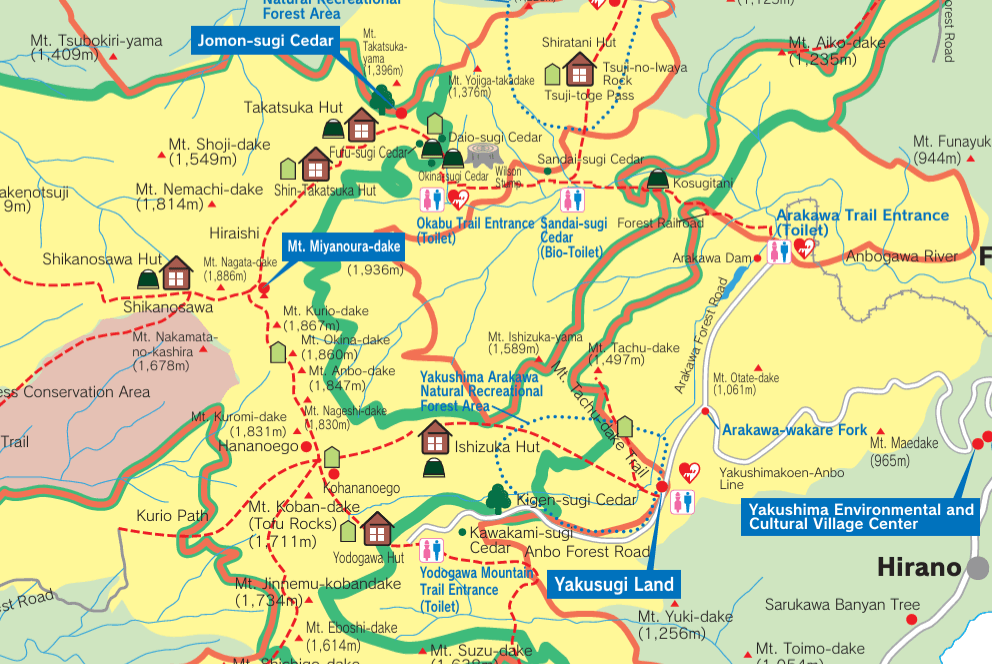
Yakushima Mountain climbing Guide and Portable Toilet Map (PDF)
Location of existing toilets (round trip from Arakawa trailhead)
・Arakawa Trailhead
・The bio-toilet located about 3 minutes from the "Kusugawa Fork"
・The end of the trolley road
・Takatsuka Shelter
・Shin-Takatsuka Shelter (Generally, you won't go this far.)
There are five locations.

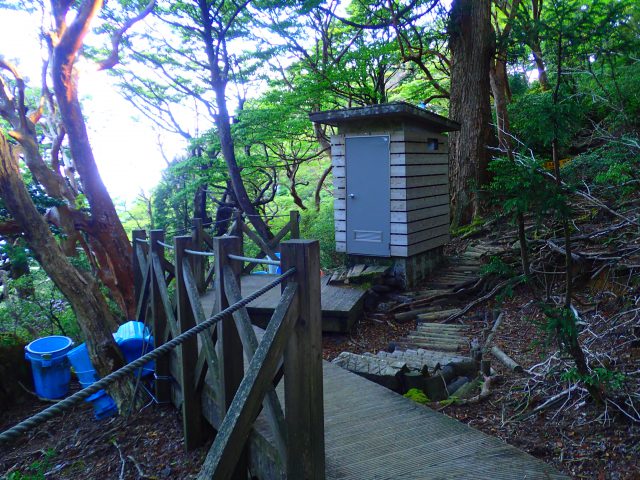
Left: Toilet at the end of the trolley road. Right: Toilet near the Takatsuka shelter.
Please do not throw trash in mountain toilets.
(Please bring your own toilet paper. Toilet paper is not provided.)
Please do not throw away garbage, sanitary products, leftover food, or food waste!
Also, please do not throw away used portable toilets and their contents here, even though they are heavy, but be sure to take them home with you!!
(You can often see them discarded around the toilets at Takatsuka Hut.)
*Also, please be careful, as some people drop their cell phones in the toilet.
At night, it's pitch black, just like the hut, so you'll need a headlamp or other lighting device.
It's a good idea to check the location while it's still light.
Location of portable toilet booths (round trip from Arakawa trailhead)
Portable toilets are available for purchase at mountaineering equipment stores, tourist information centers, souvenir shops, and accommodations.
They come in packs of one or two. The two-pack is a better deal, but if you have any left over, we can't offer a refund, so if you don't use them, please keep them as a memento of your trip or for emergencies. (^^)/.
(Some places only sell packs of two.)
*And after using the toilet, be sure to take any tissues or toilet paper you use with you!
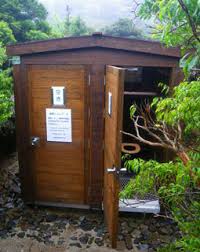
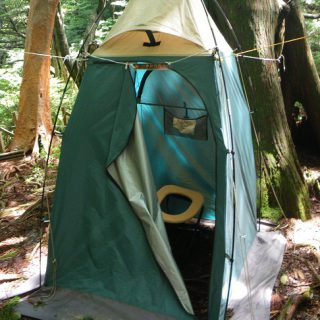
Source: Ministry of the Environment Yakushima Nature Conservation Officer's Office
Tent Booth
Former Kosugidani Elementary and Junior High School Site, Okinasugi, in front of Daiosugi, Takatsuka Shelter
(Available from March to November)
If you don't know where it is, ask a nearby guide.
Wooden Booth
Shintakatsuka Hut, about a minute's climb from Daio Sugi
Collection box for used portable toilets
In front of the Arakawa Trailhead/Yakusugi Nature Museum bus stop parking lot
(If you forget to throw it out at the Arakawa Trailhead, you can drop it off at the Yakusugi Nature Museum bus stop!)
How many portable toilets do you need?
This question is often asked.
This question is difficult to answer because it depends on the climber's physical condition and how often they need to use the restroom. However, I will answer based on the assumption that it applies to someone in average physical condition who is trekking. (;^ω^)
It depends on the season, but if you expect the existing toilets to be crowded, it might be a good idea to bring two, and if it's not a busy season, it might be a good idea to bring one as a safeguard.
*Please note that existing toilets may be unavailable due to power outages or other malfunctions. If you are concerned, please check with the tourist association or other relevant organizations beforehand.
↓ ↓ ↓
Yakushima Tourism Association Homepage
Portable toilet Click here for instructions(PDF)!(Source:Yakushima Mountain Area Utilization Measures Council)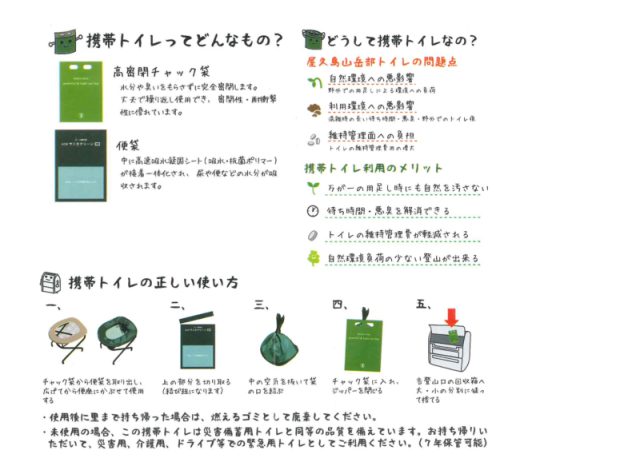
How to transport human waste from mountain toilets
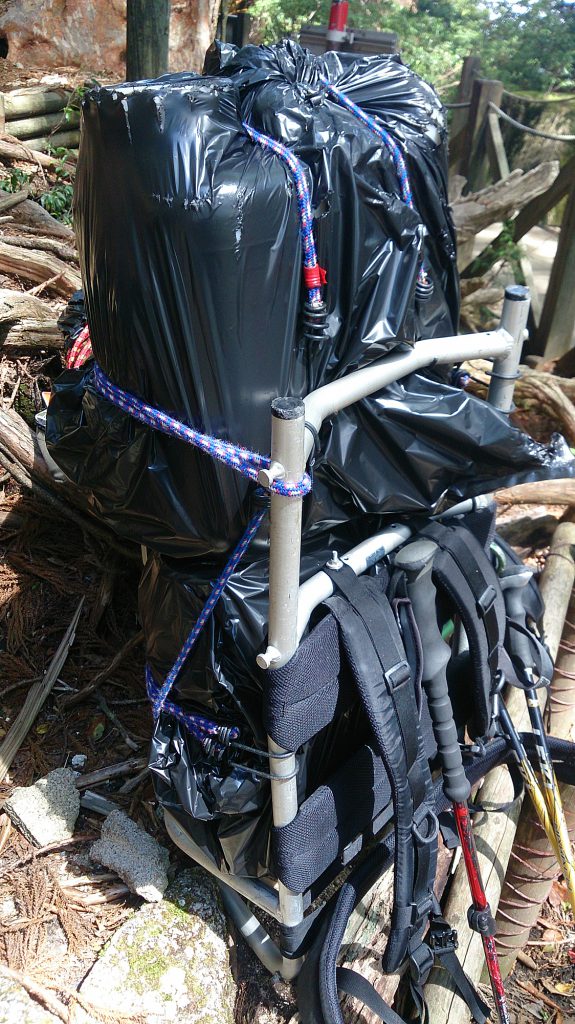
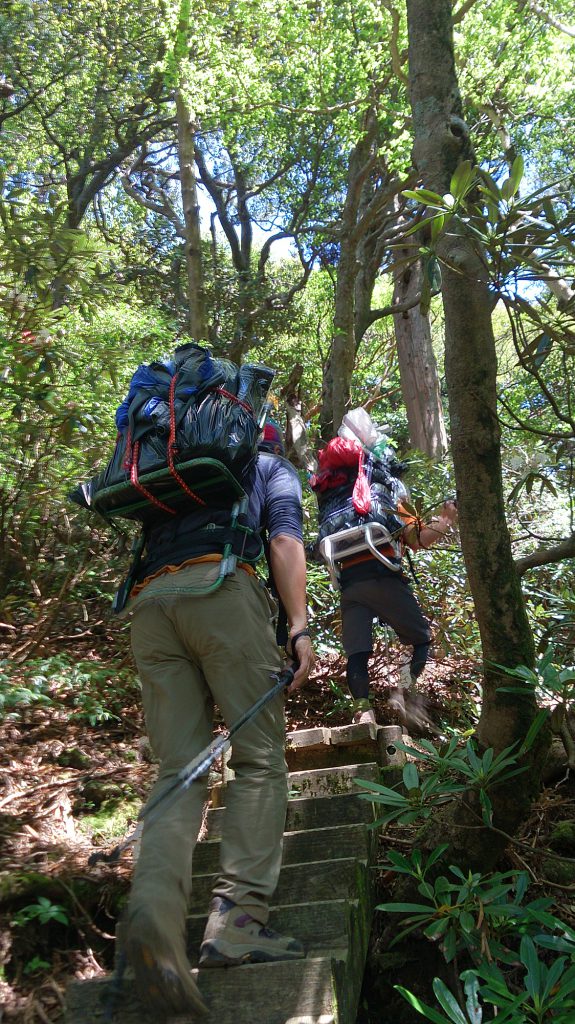
When human waste accumulates in the pit toilets at the Takatsuka and Shin-Takatsuka Hut, people regularly pump it out and manually lower it onto the trolley track.
For the sake of these people and the next person who uses the restroom, please keep it as clean as possible and strictly follow the rules!
By the way, I once had to carry human waste, and it was incredibly heavy!
Each container weighs about 20 kg, and each person carries two.
Over 40kg in total! Wow!!
You'll want to show your respect for the workers who brave the risk of injury.
If you see workers carrying human waste, please give them the right of way, regardless of whether they are climbing or descending.
Thank you in advance.
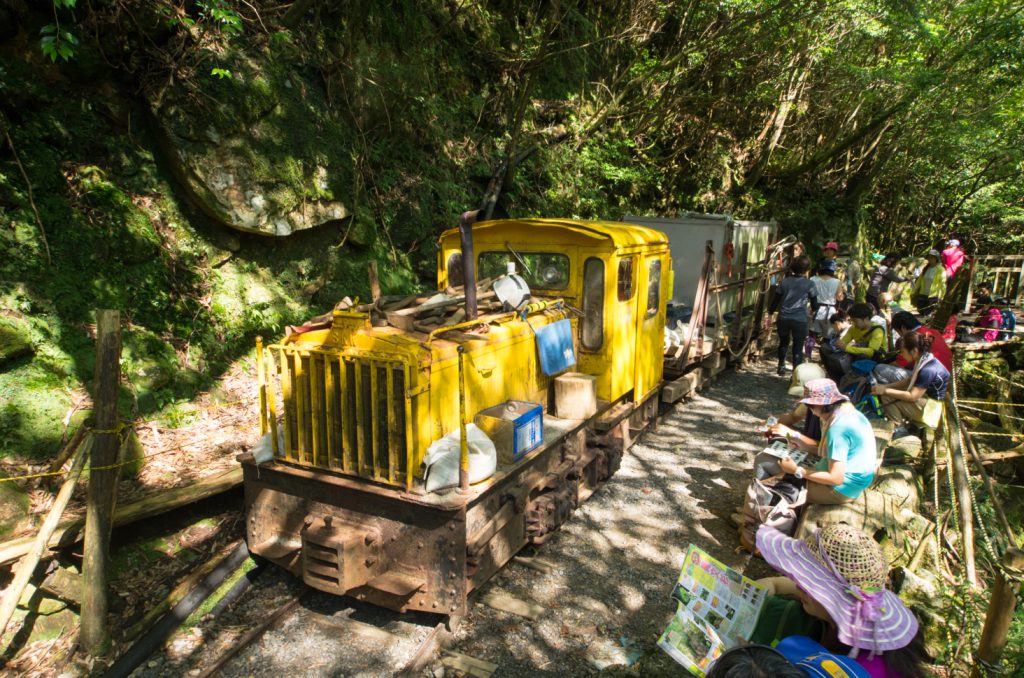

The human waste is unloaded onto the trolley track and loaded onto the trolley.
If you're lucky, you might even be able to see this trolley!
Just be careful not to get in the way of the work.
Can I use my cell phone (smartphone/iPhone) in the mountains? (Arakawa trailhead round trip route)
Please note that while the signal is reasonably strong at the location shown in the photo below, it generally does not connect in other locations.
Also, it is said that docomo (Docomo) has the best signal reception on Yakushima.
*Signal reception varies depending on the media you use.
Now, let me introduce three spots where you can get a good cell phone signal.
・Arakawa Trailhead
・Jomon Sugi Deck
・Takatsuka Hut Deck
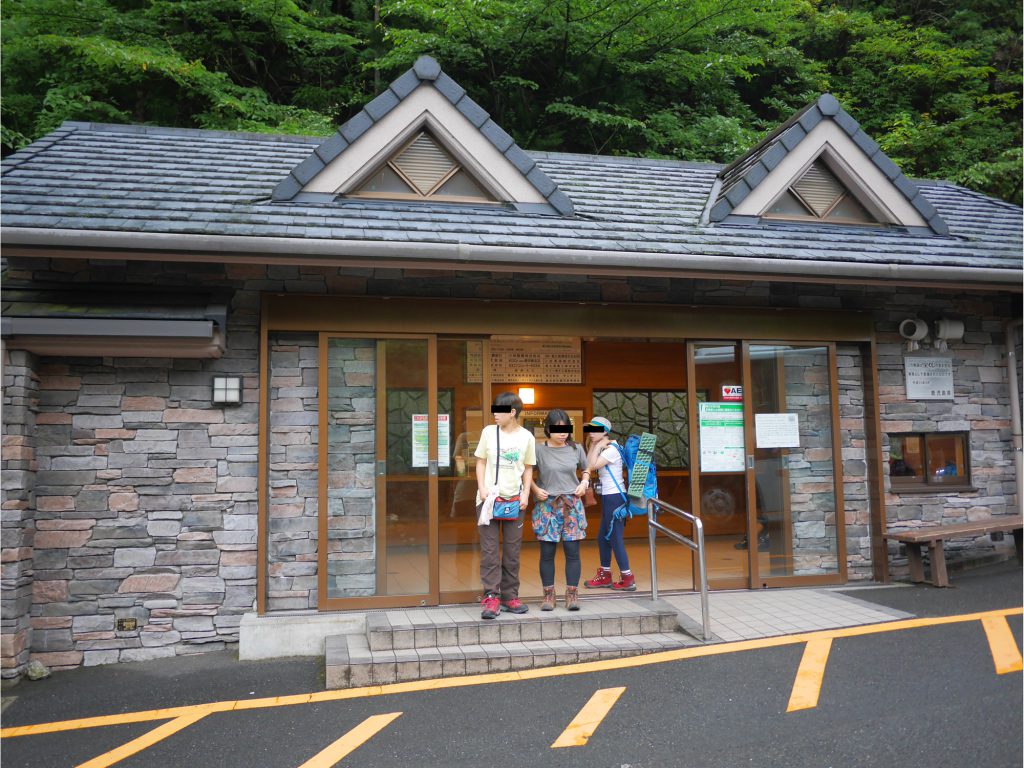

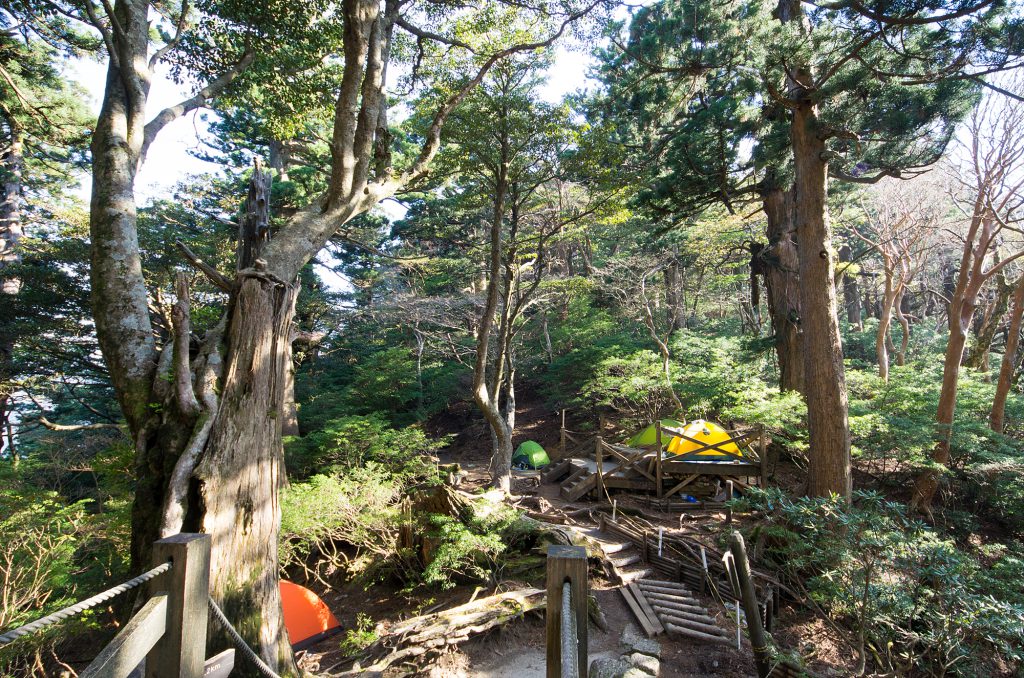
The signal is relatively strong at the Arakawa trailhead, but it's barely noticeable at the Jomon Sugi Deck and the deck in front of the Takatsuka Hut.
By the way, the Arakawa trailhead became available in June 2016, and we guides were delighted with how convenient it became.
Uninhabited huts on the Jomon Sugi course (Takatsuka Hut, Shin-Takatsuka Hut) / Tent camping
There is no mountain hut manager and no reservations are accepted, but you can use the huts for free.
Unlike typical mountain huts where meals and bedding are provided, all mountain huts on Yakushima are unmanned shelters.
And the huts are available on a first come, first served basis.
So, if the hut is already full, you'll have to camp in a tent.
*In other words, if you don't have a tent, you'll need to go to the hut early to secure a spot.
In principle, camping outside of the tent spaces around unmanned huts is prohibited except in emergencies. Please plan your hike with some leeway. (^^)
Takatsuka Hut (Lemon Gas Hut)
It was rebuilt in 2013 with a personal donation from Shintaro Akazu, president of Lemon Gas Kagoshima.
The inside of the hut is made of glass-coated cardboard tubes filled with silicone, so it's quite warm.
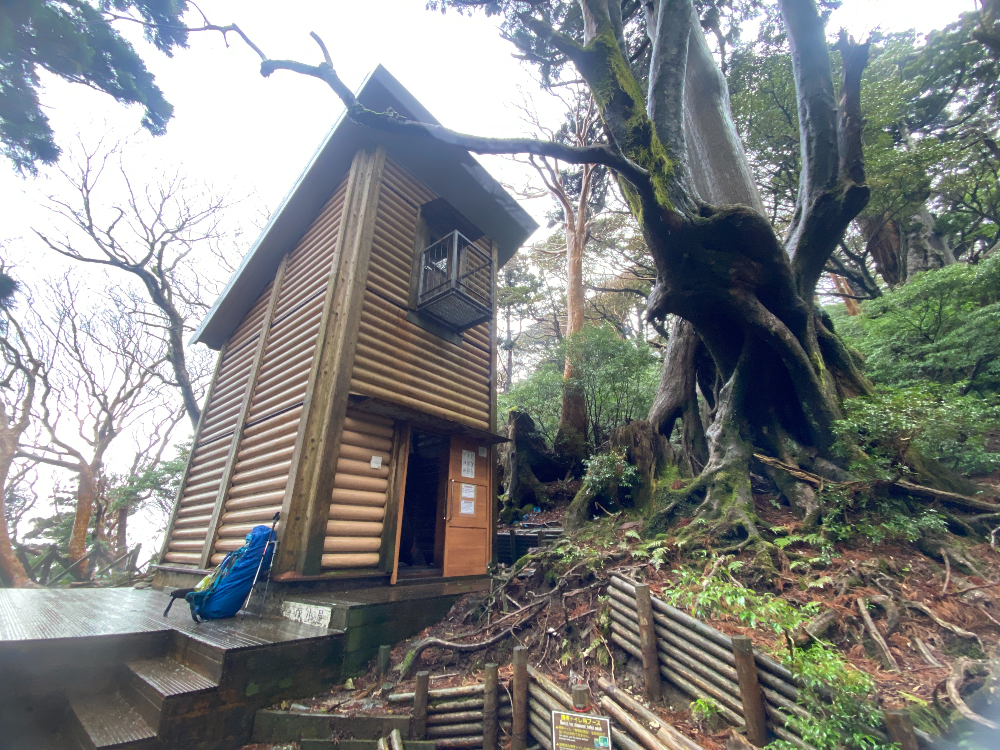
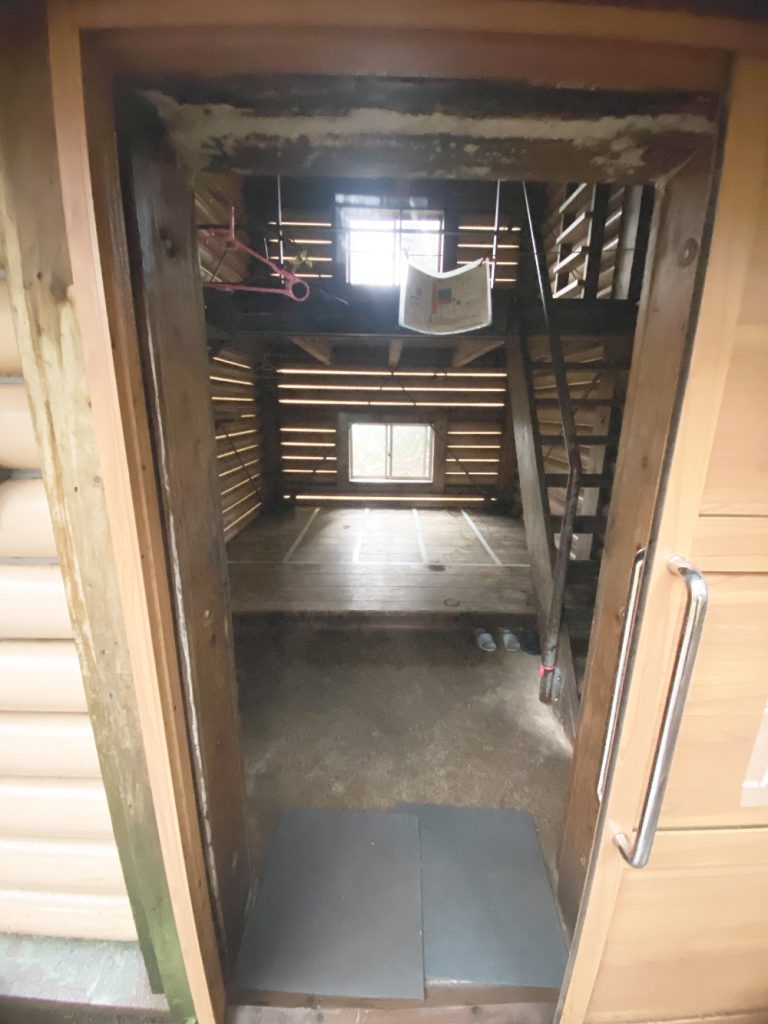
Structure: Glass-coated cardboard tube, Capacity: 20 people, Elevation: 1,330m
Water is available near the Jomon Sugi, about 10 minutes from the hut.
One pit toilet, one portable toilet tent, and a tent deck are available.
Also available are lodgings for those hiking (over Miyanoura-dake) and those coming via Shiratani Unsuikyo.
It's located about 10 minutes from Jomon Sugi, so it's recommended for viewing the Jomon Sugi lit up in the morning sun the next morning.
The hut has a limited capacity, so if you're not confident you can make it to Takatsuka Hut early, please bring a tent.
Shintakatsuka Hut
An abandoned cabin built in 1992.

Structure: Wooden, Capacity: 40, Altitude: 1,460m
Water source is located close to the hut, one pit toilet, two TSS toilets, two portable toilet booths, and a tent deck.
This is the most popular refuge hut on the popular Yakushima traverse route, which starts at the Yodogawa trailhead, crosses Miyanouradake, and leads to Jomon Sugi and Shiratani Unsuikyo.
If you are camping in a tent

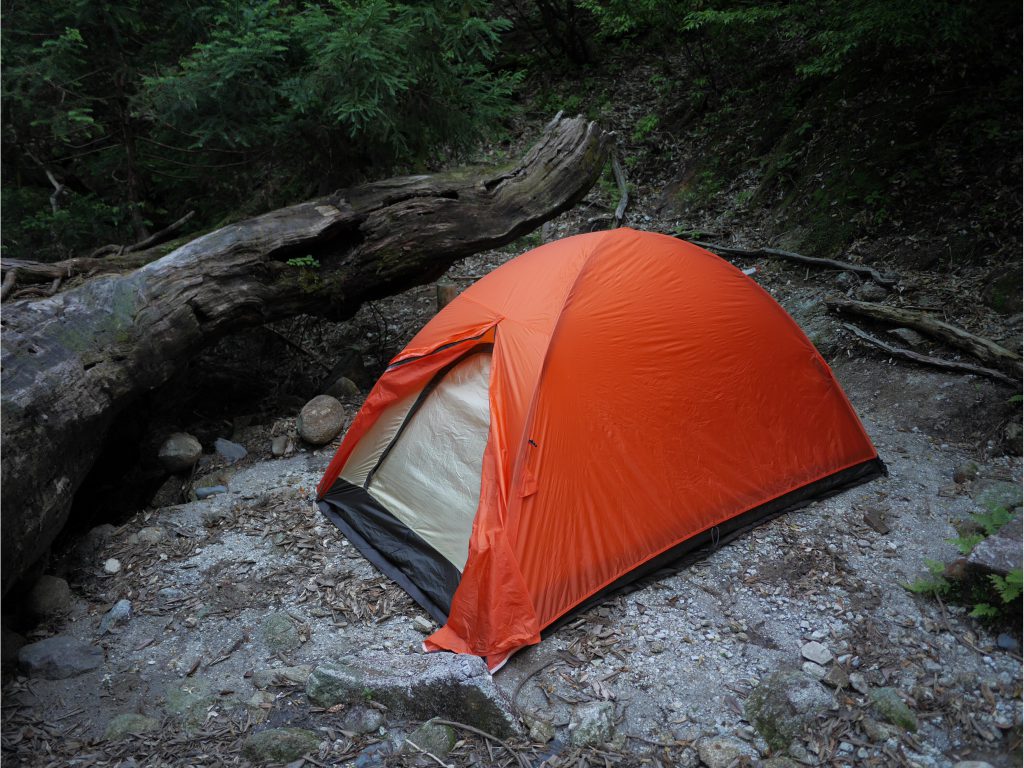
There is some space to pitch a tent around the Takatsuka Hut and ShinTakatsuka Hut.
*When we say space, we mean just a leveled area.
Space is limited, so during peak season, arrive before dark.
However, as mentioned above, if you are taking the round-trip route from the Arakawa trailhead, it is common to stay at the Takatsuka hut or the surrounding tent site.
In the first place, there aren't many hikers who stay overnight on the Arakawa trailhead round trip route, other than those on guided tours... (。-∀-)
Things to keep in mind when staying overnight in the mountains
Don't worry, there are no bears or wild boars on Yakushima!
Recently, there have been daily reports of bears in northeastern Japan. It's very frightening.
Don't worry, Yakushima is home to monkeys and deer instead.
Protect your food from Himenezumi(Small Mouse)!
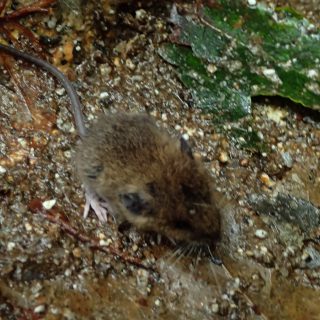
Himenezumi(Small Mouse) are likely to appear inside the hut, so be sure to store food and trash in your backpack or hang them up while you sleep.
However, I've seen people occasionally eat the entire backpack along with the food inside, so I recommend hanging it on a string instead (^^)/.
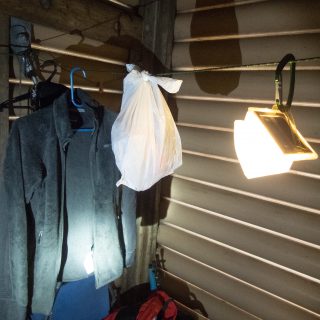
My wife had some fish sausage in the side pocket of her backpack, but the whole pocket got ripped open ( ;∀;).
If you're camping in a tent, you'll generally be fine as long as you keep your food and trash inside the tent.
Please be careful not to leave it outside as it will become prey to mice.
Double check the locations of water sources and toilets before it gets dark!
~It's easy to get there, but it's hard to get lost on the way back~
It's easy to get lost during daylight hours, but please be especially careful during the pitch black hours of late night and early morning. Apparently, there are occasional people who say, "It's right there, so it's fine!" but then fail to return even after 15 minutes.
Especially when you go to the toilet in the middle of the night, you're half asleep and half conscious. And since you're relying only on the light from your headlamp, it's surprising how many people make it to the toilet but then lose track of the way back.
Make sure to check your location during daylight hours or when you're alert!
When you leave, be sure to take your trash and anything you brought with you!
Please be sure to take your trash with you!
Perhaps out of kindness, some people leave leftover gas cans, drinks, food, etc.
I guess they're there with the intention that people should feel free to eat or use them...
I wonder when it was left there, and if it was someone's drink... I'm too scared to touch it...
It will end up in the trash, so please don't do it!
Can I retire during the trekking tour?
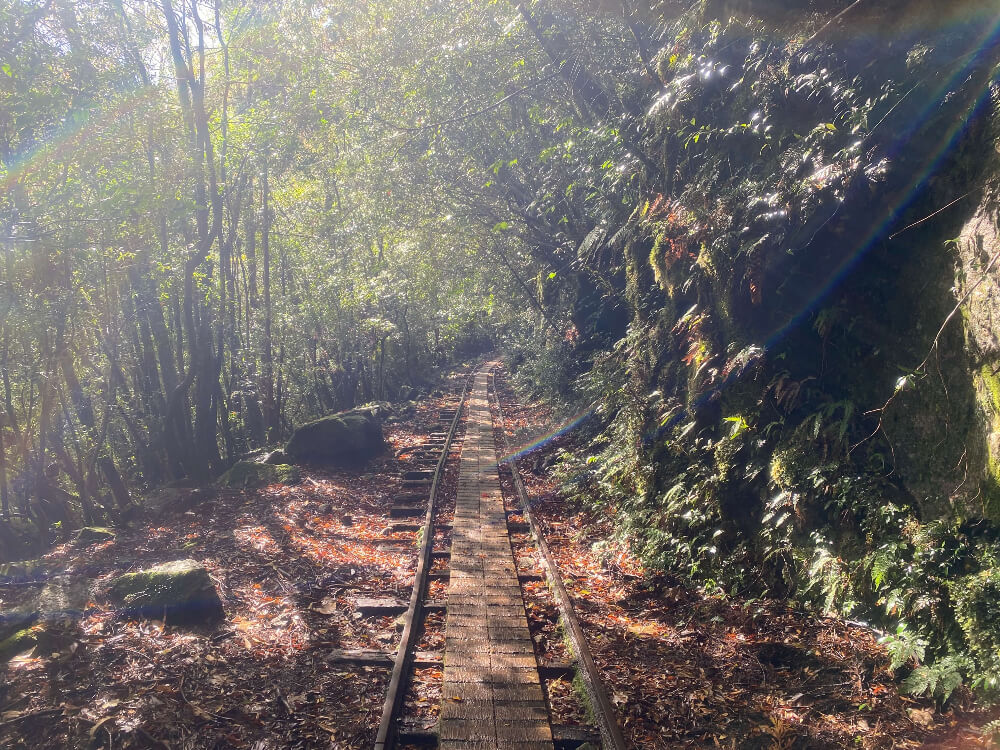
First of all, the Jomon Sugi course is quite challenging for beginners and those who are not confident in their physical strength.
The first half is mostly a trolley road, but frankly, it's a very long journey, and after that there's a substantial mountain path.
Not a few people quit midway through.
If you are participating in a tour and experience discomfort in your body or knees, please consult your guide first without making any self-diagnosis.
If you remain silent out of concern for causing trouble to other participants or those around you, it could lead to serious problems later. ?
*Taking action as soon as possible is the best way to mitigate the problem.
What can you do to avoid giving up mountaineering?
The key is to start practicing walking and climbing early on the day you decide you want to see the Jomon Sugi.
If you're busy with work, housework, and childcare and can't find time to get fit, try walking for at least 30 minutes a day, consciously taking the stairs, etc. Try to do as much training as you can every day!
If you consciously use stairs, you will build up the leg strength needed for mountain climbing.
To prevent injuries, it is very important to train your walking and climbing muscles, endurance, and physical sense.
※Personally, I think people who say things like, "I used to be very active" or "I used to climb mountains" are the most likely to retire (lol).
If you exercise regularly, this course isn't too scary.
Since you've come all the way to Yakushima, don't give up, go see the Jomon Sugi, and return home safely! (^^)/!
Tobacco in the Mountains
The Jomon Sugi trekking trail is very popular and bustles with tourists.
Meanwhile, the Yakushima Tourism Association received complaints such as, "I came here to enjoy nature, but the smell of cigarettes is disappointing," so the countermeasure council decided on a no-smoking rule.
By May 26, 2012, the Yakushima Mountain Area Utilization Measures Council, comprised of the Ministry of the Environment, Kagoshima Prefecture, and other organizations, established a voluntary rule banning smoking on hiking trails to the Jomon Sugi on Yakushima Island (Yakushima Town, Kagoshima Prefecture), a World Heritage Site. At the same time, smoking areas were also established.
There are four smoking areas (no signs) between the Arakawa trailhead and Jomon Sugi.
※If you smoke, please bring a portable ashtray and be considerate of others.
・Behind the men's restroom at the Arakawa trailhead
・The back of the Kosugidani rest house near the former Kosugidani settlement
・Next to the restroom at the end of the trolley road
・Around the Takatsuka Hut
Of course, please never smoke near bio-toilets, Jomon Sugi, or Wilson Stump.
Guides will warn you if you violate the rules.
(Since this is a place where you'll be stopping, you may be tempted to smoke, but please wait until you're in a place where you can.)
Summary
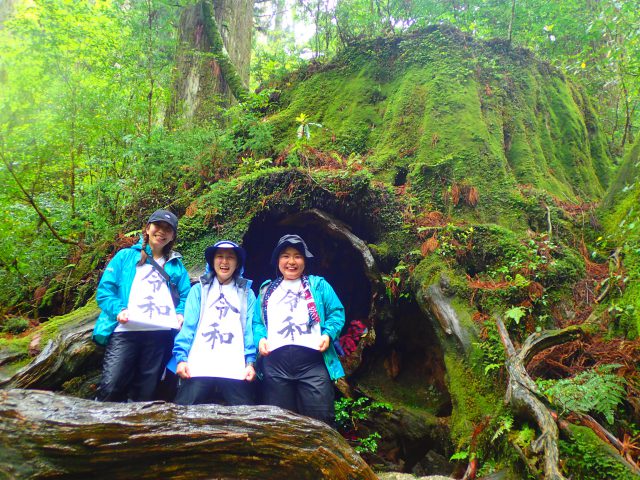
For those considering staying overnight during the Jomon Sugi trek. I've compiled a list of concerns I've received from my guests, so even those new to staying overnight in the mountains can feel at ease. What do you think?
Even if you're taking the overnight Jomon Sugi tour, I think you'll have less anxiety if you carefully research and plan your trip yourself, rather than leaving everything up to the guide.
Now, please enjoy the natural beauty of Yakushima!

